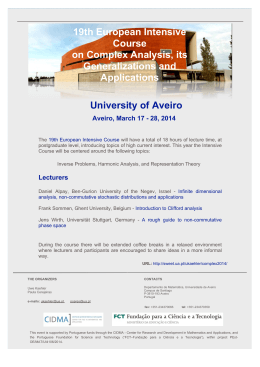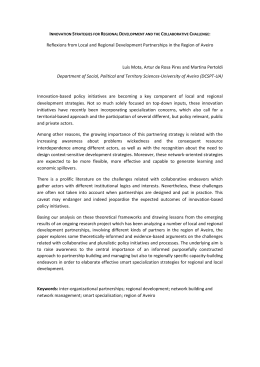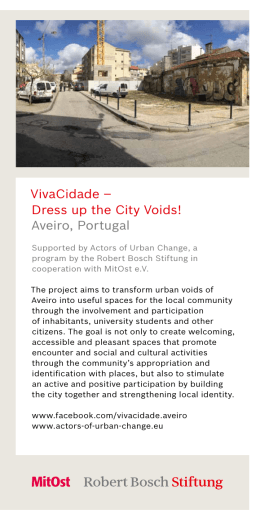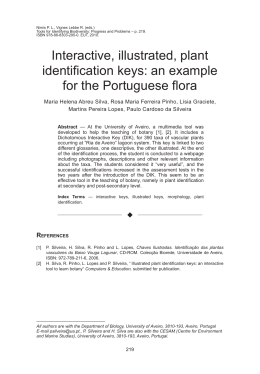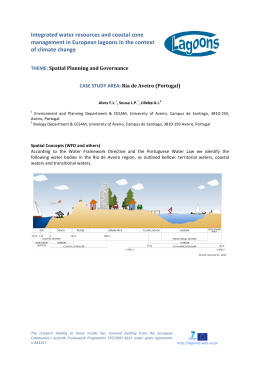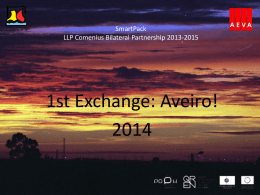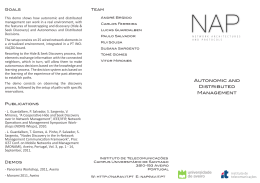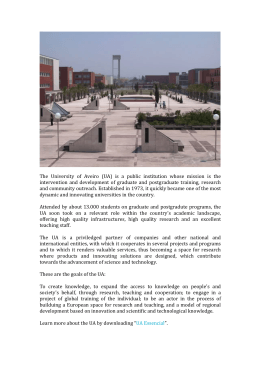Journal Journalof ofCoastal CoastalResearch Research SI 64 pg - pg 1311 1315 ICS2011 ICS2011 (Proceedings) Poland ISSN 0749-0208 Ten Years Assessment of ICZM Principles Applied at a Local Scale: Ria de Aveiro Case Study F. L.Alves†, J. V. Silva†, C. A. Pereira†† and L. P. Sousa† † CESAM – Centre for Environmental and Marine Studies, Department of Environment and Planning, University of Aveiro, 3810-193 Aveiro, Portugal [email protected], [email protected] [email protected] ‡ CESAM – Centre for Environmental and Marine Studies, Department of Civil Engineering University of Aveiro, Aveiro 3810, Portugal [email protected] ABSTRACT Alves, F., Silva, J., Pereira, C., and, Sousa, L. 2011. Ten Years Assessment of ICZM Principles Applied at a Local Scale: Ria de Aveiro Case Study. Journal of Coastal Research, SI 64 (Proceedings of the 11th International Coastal Symposium), 1311 – 1215. Szczecin, Poland, ISSN 0749-0208 The need for an integrated management for Ria de Aveiro Lagoon is not new. Back in the 90’s the European Commission stated that, concerning the management of the coastal zones, there was a lack of coordination and concertation between the governmental institutions and the different sectors of activities This circumstance was not related to the amount and quality of the management instruments and laws but due to the lack of coordination between the different stakeholders involved in this management process. This statement applied to the European space was perfectly adjusted to the Portuguese reality, in particular, to the estuary and coastal area of the Ria de Aveiro. The Aveiro lagoon is the target of several research projects as well as some action programmes. Firstly this study analyses two of the most important Portuguese research projects the MARIA and ESGIRA-MARia that were in the scope of the LIFE Environment of the European Union. Secondly this study examines also the UNIR@RIA Spatial Plan, that was designed with a strong basis on an inter-municipality level and the POLIS LITORAL Ria de Aveiro Action Programme that appears as an environmental and financial opportunity to take into action some of the required measures for the study area. This paper analyses the previously mentioned Projects and Plans; comparing them; identifying their goals, their methodology; the involved stakeholders; pointing out their success actions and their weakness; establishing a coherent line between them; and enumerating the elements passed from the beginning of the studies stage to the actions plans of nowadays. ADDITIONAL INDEX WORDS: Integrated Management; Aveiro Lagoon; Local Scale INTRODUCTION The process of Integrated Coastal Zone Management (ICZM) is based on eight principles: a broad "holistic" perspective; a long term perspective; adaptive management during a gradual process; reflect local specificity; work with natural processes; participatory planning; support and involvement of all relevant administrative bodies and; use of a combination of instruments (EC, 2002). These are the basic principles considered as essential to achieve a successful integrated coastal management process. Looking at the Portuguese context it is possible to witness an improvement made by the government in the legislation applied to the coastal zones, in order to prepare a robust legal base in matters of governance (institutional and competences) (MAOTDR, 2009). There was an effort made towards the introductions in the national sectorial policies several objectives of the European Recommendations as regards the Integrated Coastal Zone Management (CEC, 2000), these acts can be seen in the National Strategy of Sustainable Development (APA, 2006). On the other hand, the financial resources made available for actions of coastal defense and of environmental protection have been suffering a significant increase in the last years. This particularly aspect clearly demonstrates the importance that the coastal zone assumes in the national and local performing strategies due the strong and complex problems existing (Alves and Ferreira, 2006). The Portuguese government has approved, in 2009, the National Strategy for Integrated Coastal Zone Management (NSICZM) (MAOTDR, 2009). The Portuguese national strategy identified as main principles: Sustainability and Intergenerational Solidarity; Cohesion and Equity; Prevention and Precaution; Systemic Approaches; Technical and Scientific Knowledge; Subsidiarity; Participation; Co-responsibility; and Operability. However, the concerns with coastal zones are not new and the need for an integrated management strategy for the Aveiro lagoon has been the target of several research projects and spatial planning interventions, during the last decade. As mentioned before, in the early 90’s the European Commission stated that there was a lack of coordination and concertation in the coastal spatial management acts. This was principally related to the stakeholders (government and sectors) involved and not with the planning documents themselves. That reality led to a research project, in 1996, in the scope of the Programme on Integrated Management for the Ria de Aveiro – Journal of Coastal Research, Special Issue 64, 2011 1311 ICZM in Aveiro Lagoon MARIA (LIFE96 ENV/P/000601). This first European project was continued in 1999 by another one, the ESGIRA-MARia (LIFE99 ENV/P/000673) as a follow-up of the operationally of the main principles of ICZM. Later, in 2008, the eleven municipalities surrounding the Aveiro lagoon joined their strength and created the UNIR@RIA. An inter-municipal spatial plan was design and approved for this particularly territory. Nowadays, the interventions strategies for the recovery and protection of the Aveiro lagoon are being managed by a specific programme, named POLIS LITORAL Ria de Aveiro (PARQUEXPO, 2008). STUDY AREA The Aveiro Lagoon, situated on the northern coast of Portugal, is a shallow water lagoon separated from the Atlantic Ocean by a sandy dune barrier. It has an irregular geometry the only existing connection with the ocean is artificial and was opened in the beginning of the 19th century. The lagoon has a maximum width of 10km and it extents for around 45 km (Figure 1) (Dias, 2001). agriculture, holds a large number of small traditional fishing ports, houses the Aveiro’s Harbor, has aquaculture activities, it is an important place for the tourism with a growing subsector in the water sports area and it’s also related to the traditional salt production activities. It was once and important area of salt production, its production area occupies around 15 km2, and in the 15th century it had around 500 active saltpans. The amount of saltpans has been decreasing very rapidly in the last years and nowadays there are only 8 active ones (Picado et al., 2009). Part of their activity is now related to tourism as well, acting like a living, functioning museum – Ecomuseu da Troncalhada (Eco-museum). From the nature conservation and biodiversity point of view, it is a high value area, both locally and nationally. It has a rich fauna and flora housing a large number of species. Due to rich variety of species the Aveiro lagoon was classified as a Special Protected Area, a classification that comes from the application of the Birds Directive (Directive on the conservation of wild birds – 79/409/EEC). It contains also an important protected area, the Natural Reserve of ‘Dunas de São Jacinto’. A well preserved dune barrier located in the seaside area of the lagoon with several ponds that present themselves as an essential habitat for numerous local and migratory birds. Besides the key agents with legal competences to intervene in the lagoon territory, there are also a large number of other entities with direct or indirectly interests in the lagoon. Summarizing, we are looking at a coastal lagoon that is influenced by: tidal regime; possessing a complex and characteristic biota; favorable to the simultaneous course of natural and anthropic processes. Due to its large social, economic and patrimonial diversity it has also a complex legal and institutional structure (Alves et al., 2000b). PROJECTS, PLANS AND PROGRAMMES MARIA Project In 1996, the University of Aveiro established with the local, regional and central government, as well as with different local associations, a partnership for a project called MARIA – Integrated Management Program for the Aveiro Lagoon. This project was a part of the ICZM Demonstration Programs funded by EU Programme LIFE’96. Their goal was to find tools that allowed a management framework orientated for a better and integrated development and also to improve the stakeholders participation and conciliation of interests, not only for the Aveiro coastal lagoon but also for other coastal lagoons with similar characteristics (Alves et al, 2000b). Main goals Figure 1. Ria Aveiro Lagoon study area The area of the lagoon is in constant change since it is strongly influenced by tides. During spring tides the area goes from 66 km2 at low tide to 85 km2 at high tide (Dias, 2001). It has an average depth of 1 m, but it also has areas, especially the navigation channels close to its mouth and the contiguous port areas, that are deeper due to constant dredging operation to allow access of bigger vessels to the port. It is a mesotidal lagoon with a tidal amplitude in average of 2 m but it can varies at the inlet from 0.6 in neap tides to 3.2 m in spring tides (Dias et al., 2000). The Aveiro lagoon is a very important ecosystem to the local economy and to the environment. It acts as keystone to the local The propose of this Project comes from two specific main goals that were: to build the capacity of several different entities to work together; to take profit from the investments and interventions done in a common area (the lagoon) in defining cooperation approaches to ensure a sustainable use of this special space. Key-agents There were various agents involved in this project form the regional to local government. These entities have legal competencies to intervene on the lagoon. The project has integrated also: the Industrial District Association; the Agricultural and Rural Development Institute; the Institute for Nature Conservation and Biodiversity, and local nongovernmental associations. The University of Aveiro played an Journal of Coastal Research, Special Issue 64, 2011 1312 Alves et al. important role as a R&D institution but also as a ‘neutral’ partner, leading this partnership. Methodology To achieve the proposed main goals the methodology used in this project was develop in three sequential stages that were all interconnected (Figure 2). general disjointed nature of actions taken at different levels of the administration, the inadequacy of legislation and instruments for implementation and the lack of co-ordination between the different groups/ sectors using coastal lagoon area (Alves et al., 2000b; Alves et al.,2001a). Main goals The project was design to take advantage of the previously opened paths of cooperation between the different stakeholders allowing a better implementation of the pilot projects that came out of the MARIA Project. As a goal, it set to test the efficiency of an Integrated Management Structure through negotiation among the various interests groups (a wide-ranging partnership was created within the framework of the 1996 LIFE project - MARIA), to contribute to the identification of integrated management methodologies for coastal areas and to identify mechanisms that allow the (re) shaping of a structure of this typology. Key-Agents Figure 2. MARIA Methodology (DAO/UA, 1999) The first stage of work consisted in identify and synthesise the existing information to assess the present situation frame. The second stage, consisted in the analysis and evaluation of the existing projects, plans and programmes assessing the interference level in the natural ecosystems, their contribution to the environment degradation and mitigation measures foreseen in them. This allowed to identify the concerted actions, or lack of them, this would act as a hint on the recommendations elaboration. To the success of this stage, the information trade process between the different agents was fundamental. In the third stage the partners of the MARIA Project, considering the identified problem, intended to contribute to a definition of integrated management structure for the Aveiro coastal lagoon. This structure would also have to be tested regarding its ability to manage the multiplicity of environmental vectors of the lagoon region. To achieve those results there were four main areas that the project identified as a priority: the traditional fishery activities, the salt production, the agricultural practices and the landscape protection. Results The MARIA Project managed to create routine of cooperation and conciliation between the different stakeholders involved in the Aveiro lagoon management. It helped to create a definition of an integrated management structure for the sustainable development of the area. It created routines of dialog where there were none. As a European Demonstration Programme it was also possible to share the experience and share its findings. For the national reality one important result of the project was the definition of the four priority areas that were the basis for the ESGIRA-MARia Project. ESGIRA-MARia Project The ESGIRA-MARia (Integrated Management Structure for the Aveiro Lagoon) Project started in 1998 and it was a co-financed project by the European Union in the scope of the environment LIFE’99. The main idea was to continue the work done in the MARIA Project, accessing the efficiency of the proposed integrated management structure and also to respond to some identified weakness, principally in the lack of coordination and The team involved in this project was a bit wider than in the MARIA. The core group of the project, led by the University of Aveiro, felt the need to embrace more agents so that project could reach even further than before. A part of the University members the team had members from local and regional government, from a number of regional associations, from the industrial, the environment, the tourism and non-governmental entities. The idea was to get a multidisciplinary view over the lagoon and its management issues. Methodology The method used was based on the four priority areas of the MARIA Project. These areas led to the creation of four different pilot projects: • Rehabilitation and valorization of the existing piers along the lagoon channels; • Rehabilitation of the salt marines (saltpans); • Management of the “Baixo-Vouga” agricultural field allowing the co-existence of the agricultural activities with the existing natural habitats; • Implementation of measures that promote the classification and the integrated management of the protected landscape area of the Cáster river mouth. These pilot projects came from the need to develop wide enough actions that integrated all the physic geographic area of the lagoon area that had already been subject of a previous investigation and would be seen as an example of the daily management issues of the lagoon. The projects were explained to the involved stakeholders and the population by having specific formation sessions, various workshops, the inclusion of the project on the University Open Week (One week of the year that the University opens its doors to the outside community allowing schools to see what kind of work is done in the University) and scientific exhibits in the municipalities (Alves et al., 2000a; Alves et al., 2000b; Alves et al., 2001b). Results The main results of the ESGIRA-MARia Project are connected to the strengthening routines of the cooperation between the different stakeholders and concertation of interests, there were significant progresses when compared with the MARIA Project. The developed work divided in specific groups inherent to each pilot project promoted a larger interaction which allowed a greater Journal of Coastal Research, Special Issue 64, 2011 1313 ICZM in Aveiro Lagoon capacity of knowledge transfer that was reflected on the quality of the final product of each pilot project. The work done in each project was transferred to the local population which enhanced the identity feeling allowing a greater sense of awareness to the lagoons issues and the solutions proposed and in execution. The project managed to raise attention to the lagoon and to the need of an integrated management. Another output of the project was a number of publications in journals, conferences and books that allowed the dissemination of the findings to go even further. POLIS LITORAL Ria de Aveiro programme Nowadays the Aveiro coastal lagoon is the target of another programme, the POLIS LITORAL Ria de Aveiro. This programme is now overseeing the interventions strategies for the valorization and recuperation of the lagoon. The POLIS LITORAL Ria de Aveiro is one of the four national POLIS LITORAL programmes. These programmes are made for problematic, troubled pressured areas and have special funding mechanisms. Main goals UNIR@RIA Plan In early 2000 the inter-municipal spatial plan UNIR@RIA (AMRia/CPU, 2006) started to be drawn and it was only concluded in 2008. The plan aims to establish integrated guidelines for the surrounding territory of the Aveiro lagoon and its natural extension trough the drainage basin of the Vouga and Cértima River. Main goals The main objective of this plan is to achieve the sustainable development and qualification of the Aveiro Lagoon and surrounding territory. To succeed, the plan set a pair of fundamental strategic vectors, the lagoon as a privileged natural space and the lagoon as an integrated, cohesive and dynamic socio-economic space. This plan counted with the participation of the local, regional and national government and it took into account several existing plans for the lagoon (AMRia/CPU, 2006; Sousa et al., 2010). Methodology To elaborate the plan several characterization studies were made to access the lagoons territorial reality. This was also complemented with the existing studies and municipal projects that were considered a priority for the lagoon’s sustainable development. There was a concern to take into consideration the high hierarchical plans such as the regional spatial plan and the coastal zone management plan to achieve the necessary concertation and articulation between all the existing plans. To accomplish the vision of the lagoon as a natural space the plan set measures to rehabilitate degraded and abandoned areas ensuring that the natural values would be considered as a priority instead of other uses and functions. This would be achieved through an environmental information and education of the surrounding population regarding the natural value of the Aveiro lagoon and the need to preserve its natural values. To reach the vision of an integrated, cohesive and dynamic socio-economic space the plan set to conversion of the agriculture sector allowing the development of sustainable policies based on best environmental practices and supporting the maintenance of production systems. It would also set to promote the traditional activities compatible with nature conservation creating equilibrium conditions between production and natural values. The plan also intends to improve the accessibility of the area taking advantage its position and complementing the existing roads networks allowing an easier accessibility both to the local and outside population (AMRia/CPU, 2006). Results The lack of funding currently one of the main threats to the plans execution and a large number of the foreseen action were put on standby. We can also conclude that the process of defining a strategy is not consensual making it a very time-consuming act. The programme is based in three main objectives that originated four vectors of work and twenty nine sub vectors: • An environmental preserved lagoon: coastal and lagoon defense and protection minimizing risks; valorization and protection of the natural patrimony and landscape; • Economic dynamic lagoon: valorization of the economical resources as a social and economic competitive factor; • Lagoon of multiple existences: promotion and dynamisation of the lagoon. Methodology One of the main differences between this programme and the previous plan is that the POLIS started where the UNIR@RIA began to have a lack of municipal financial support. Most actions proposed on the other plans stopped when funding was not available so, to avoid that, the “POLIS LITORAL Ria de Aveiro” started with the funding for each vector already accounted for. The amount of funding was limited and had to be distributed, but it counted with approximately 96 million Euros (59% European funds and 41% National funds). This allows the studies to begin with the certainty that the propose actions would actually be implemented and carried out. The Portuguese government created a legal society to co-manage the programme along with the regional and the studies are made by multidisciplinary teams involving a large number of stakeholders and users of the lagoon (PARQUEXPO, 2008). Results Some of the proposed studies have already been approved and at least seven projects are being implemented and built. DISCUSSION AND CONCLUSIONS The MARIA research project opened the ways of communication between the different stakeholders involved in the lagoon management and showed the benefits of an integrated approach to the lagoons management. This was a critical factor to a better management due to the lagoon’s social, economical and cultural dynamics. Once the path of communication was established, the fallowing project, the ESGIRA-MARia, took those relations to another level. The communication’s bonds between the stakeholders were strengthened and the execution of the pilot projects was a clear demonstration, both to the stakeholders and the local population, of how an ICZM strategy could be helpful in the lagoon’s management. The two research projects, regarding the ICZM policies and principles, created a clear coordination and conciliation between the large number of stakeholders involved in the lagoon management and its users resulting in a new way to see the lagoon management. This allowed the elaboration of the UNIR@RIA plan. There was a clear difference between this plan and the previous ones. The stakeholders involved were no longer alone on Journal of Coastal Research, Special Issue 64, 2011 1314 Alves et al. Table 1: ICZM principles present in the subjects of analysis ICZM Principles MARIA A broad "holistic" perspective A long term perspective Adaptive management during a gradual process Reflect local specificity Work with natural processes Participatory planning Support and involvement of all relevant Administrative bodies Use of a combination of instruments ESGIRA-MARia UNIR@RIA POLIS LITORAL Ria de Aveiro √ √ √ - √ √ √ √ √ - - √ - √ √ √ √ √ √ √ - √ √ √ √ - √ √ √ the planning process and they had the necessary mechanisms to reach the population for a participatory planning process, leading to a better management strategy and better intervention proposals. The POLIS LITORAL Ria de Aveiro action plan raised above all other due to the economical opportunity that it represents. That advantage enabled to achieve some of the previously proposed actions that migrated from the UNIR@RIA plan to the POLIS. The background studies were based on the existing knowledge and done with multidisciplinary teams taking advantage of the currently existing philosophy of dialog and coordination between the different stakeholders. The success of the POLIS LITORAL Ria de Aveiro and the fast transition between the studies to the projects themselves is due to the economical effort made to ensure that each project had a preset budget and that the financial condition to execute them were already accounted for. The analysis done in this study show, that the ICZM principles implementation is a complex and time consuming task. Considering the dates of the analysed projects, plans and programmes by this study and examining the Table 1, it can be stated that it is only after more than ten years of the first notions of coordination, concertation and integrated management in the spatial planning acts, that the Ria de Aveiro Lagoon has finally been covered by all the principles involved in ICZM. It can also be said that despite the main importance of the coordination and conciliation approach, the financial aspects are essential to execution of the management strategies and plans. REFERENCES Alves, F., Martins, F., Coelho, C., 2000a. The contribution of an European Life project to the revitalisation of the urban waterfront in a coastal lagoon - a case study from Portugal". Coasts at the Millennium. Proceedings of the 1th International Conference of The Coastal Society, (Portland, USA), 630-634. Alves, F., Martins, F., Coelho, C., & Fonseca, H., 2001a. Recuperation and Optimisation the Ria de Aveiro´s Quays: an Example of ICZM in Portugal, World Planning Schools Congress - Planning for Cities in the 21st Century: Opportunities and Challenges. (Shanghai, China). Alves, F., Martins, F., Coelho, C., & Fonseca, H., 2001b. Recuperação e Valorização dos Cais de Acostagem da Ria de Aveiro: um exemplo de parceria. Livro de Actas da VII Conferência Nacional sobre a Qualidade do Ambiente. (Aveiro) University of Aveiro, pp. 737-745. Alves, F; Martins, F; Ferreira, I; Cunha, L; Hermoso, J. and Coelho, C, 2000b. European life project: A global strategy for the responsible use of a coastal lagoon. A case study from Portugal, Portugal, Periodicum Biologorum, Volume: 102. 385-390. Alves, F and Ferreira, J.C., 2006. 10 Years after the Rio Summit – the Assessment of. Portuguese Coastal Zone Planning System, Portugal. Journal of Coastal Research, Volume 2, 935-940. AMRia/CPU, 2006. Plano Intermunicipal de Ordenamento da Ria de Aveiro – Relatório do Plano, versão final, Aveiro, Portugal, 186pp. APA, 2006. Estratégia Nacional de Desenvolvimento Sustentável. Agência Portuguesa do Ambiente. Lisboa, Portugal, 54p. DAO/UA, 1999. Integrated Management Programme for Ria de Aveiro – MARIA, Final Report (LIFE96 ENV/P/000601). Aveiro: Portugal. DAO/UA, 2002. Integrated Management Structure of Ria de Aveiro: ESGIRA-MARIA, Final Report (LIFE99 ENV/P/000673). Aveiro: Portugal. Dias, J.M.; Lopes, J.F. and Dekeyser, I., 2000. Tidal propagation in Ria de Aveiro Lagoon, Portugal. Physics and Chemistry of the Earth (B) 25 (4), 369-374. Dias, J.M.; Lopes, J.F. and Dekeyser, I., 2001. Lagrangian transport of particles in Ria de Aveiro lagoon, Portugal. Physics and Chemistry of the Earth (B) 26, 721-727. CEC, 2000. Communication from the Commission to the Council and the European Parliament on Integrated Coastal Zone Management: A Strategy for Europe. Brussels: Commission of the European Communities, COM(2000) 547 final. EC, 2002. Recommendation of the European Parliament and Council concerning the implementation of Integrated Coastal Zone Management in Europe. Brussels: Official Journal of the European Communities. 2002/413/EC. EEC, 1979. Council Directive on the conservation of wild birds. Luxembourg: Official Journal of the European Communities 79/409/EEC. PARQUEXPO, 2008. Ria de Aveiro intervenção de requalificação e valorização – Relatório final. Ministério do Ambiente e Ordenamento do Território e do Desenvolvimento Regional. Aveiro: Portugal, 199p. Picado A., Dias J.M., and Fortunato A., 2009. Effect of flooding the salt pans in the Ria de Aveiro. Journal of Coastal Research, SI56, 1395-1399. Sousa, L., Silva, J. and Alves, F.L., 2010. Methodological aspects to consider in the Vouga Estuary Management Plan. Book of abstracts of the International Conference on Coastal Conservation and Management in the Atlantic and Mediterranean (Estoril, Portugal), pp.119. ACKNOWLEDGEMENTS We would like to thank the MARIA and ESGIRA-MARia projects teams for all provided support. Journal of Coastal Research, Special Issue 64, 2011 1315
Download
